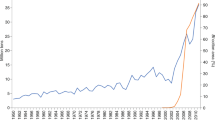Abstract
The objective of this study is to examine whether or not the gains from reduced spraying for bollworms are being sustained more than one decade after the initial adoption in 2007. Based on farm-level data collected by the authors in 1999–2007 in 16 villages from 4 provinces, this study shows that insecticides applied for controlling bollworms have declined. This analysis supports Chinese policy makers’ decision to not require refuges of non-Bt cotton fields. It also suggests that past studies may have underestimated the benefits from adopting Bt technology.
Similar content being viewed by others
References
James C. Global status of commercialized biotech/GM Crops: 2007. ISAAA Briefs No. 37, International Service for the Acquisition of Agri-biotech Applications, Ithaca, NY. 2007
Perlak F J, Oppenhuizen M, Gustafson K, et al. Development and commercial use of Bollgard® cotton in the USA—early promises versus today’s reality. Plant J, 2001, 27: 489–502, 1:STN:280:DC%2BD3MrjtVOnsw%3D%3D, 10.1046/j.1365-313X.2001.01120.x, 11576434
Traxler G, Godoy-Avila S, Falck-Zepeda J, et al. Transgenic Cotton in Mexico: Economic and Environmental Impacts (unpublished report). Auburn: Auburn University, 2001
Ismael Y, Thirtle C L B, Bennett R, et al. Smallholder adoption and economic impacts of Bt cotton in the Makhathini Flats, Republic of South Africa. Report for DFID Project R7946. London: Natural Resources Policy Research Programme, 2001
Huang J K, Rozelle S, Pray C, et al. Plant biotechnology in China. Science, 2002, 295: 674–677, 1:CAS:528:DC%2BD38XptF2ktw%3D%3D, 10.1126/science.1067226, 11809972
Huang J K, Hu R F, Pray C, et al. Biotechnology as an alternative to chemical pesticides: a case study of Bt cotton in China. Agr Econ, 2003, 29: 55–67, 10.1111/j.1574-0862.2003.tb00147.x
Pray C E, Huang J K, Hu R F, et al. Five years of Bt cotton in China- the benefits continue. Plant J, 2002, 31: 423–430, 1:CAS:528:DC%2BD38XnvVSqt74%3D, 10.1046/j.1365-313X.2002.01401.x, 12182701
Qaim M, Zilberman D. Yield effects of genetically modified crops in developing countries. Science, 2003, 299: 900–902, 1:CAS:528:DC%2BD3sXpt1SgsA%3D%3D, 10.1126/science.1080609, 12574633
Bates S L, Zhao J Z, Roush R T, et al. Insect resistance management in GM crops: past, present and future. Nat Biotechnol, 2005, 23: 57–62, 1:CAS:528:DC%2BD2MXhsFGmtw%3D%3D, 10.1038/nbt1056, 15637622
Carrière Y, Ellers-Kirk C, Sisterson M, et al. Long-term regional suppression of pink bollworm by Bacillus thuringiensis Cotton. Proc Natl Acad Sci USA, 2003, 100: 1519–1523, 10.1073/pnas.0436708100, 12571355
Wu K M, Lu Y H, Feng H Q, et al. Suppression of cotton bollworm in multiple crops in China in Areas with Bt toxin-containing cotton. Science, 2008, 321: 1676–1678, 1:CAS:528:DC%2BD1cXhtFamtrrL, 10.1126/science.1160550, 18801998
Huang J K, Hu R F, Rozelle S, et al. Transgenic varieties and productivity of smallholder cotton farmers in China. Aust J Agr Resour Econ, 2002, 46: 367–387, 10.1111/1467-8489.00184
Pray C E, Ma D M, Huang J K. Impact of Bt cotton in China. World Dev, 2001, 29: 813–825, 10.1016/S0305-750X(01)00010-9
Wang S H, Just D, Andersen P. Tarnishing Silver Bullets: Bt Technology Adoption, Bounded Rationality and the Outbreak of Secondary Pest Infestations in China, Applied Economics and Management Department. Cornell Universit, 2005
Pemsl D, Waibel H, Gutierrez A P. Why do some Bt-cotton farmers in China continue to use high levels of pesticides? Int J Agr Sustain, 2005, 3: 44–56
Moar W J, Smith R H. Bt resistance monitoring of tobacco budworm and cotton bollworm in Alabama cotton. In: Let’s Get Everyone Involved. Proceedings Beltwide Cotton Conferences, San Diego, 1998. 1054–1056
Wang Z J, Lin H, Huang J K, et al. Bt cotton in China: Are secondary insect infestations offsetting the benefits in farmer fields. Agr Sci China, 2009, 8: 101–105, 1:CAS:528:DC%2BD1MXmtVykur4%3D
The United States Environmental Protection Agency. U.S. Environmental Protection Agency FIFRA Scientific Advisory Panel, Subpanel on Bacillus thuringiensis (Bt) plant-pesticides and resistance management February 9–10, 1998. Docket No. OPPTS-00231
Fitt G P. Transgenic cotton resistance strategy. Australian Cottongrower. 1996, 17: 30–31
Wu K M, Guo Y Y, Gao S S. Evaluation of the nature refuge function for Helicoverpa armigera (Lepidoptera: Noctuidae) within Bacillus thuringiensis transgenic cotton growing areas in North China. J Econ Entomol, 2002, 95: 832–837, 10.1603/0022-0493-95.4.832, 12216828
Wu K M, Feng H Q, Guo Y Y. Evaluation of maize as a refuge for management of resistance to Bt cotton by Helicoverpa armigera (Hubner) in the Yellow River cotton-farming region of China. Crop Protect, 2004, 23: 523–530, 10.1016/j.cropro.2003.10.009
Wu K M, Guo Y Y. The evolution of cotton pest management practices in China. Annu Rev Entomol, 2005, 50: 31–52, 1:CAS:528:DC%2BD2MXhtFOqt7w%3D, 10.1146/annurev.ento.50.071803.130349, 15355239
Xue D Y. A summary of Research on the Environmental Impacts of Bt cotton in China. Hong Kong: Green Peace, 2002
Pingali P L, Carlson G A. Human capital, adjustments in subjective probabilities, and the demand for pest controls. Amer J Agri Econ. 1985, 67: 853–861, 10.2307/1241826
Wu K M, Mu W, Liang G M, et al. Regional reversion of insecticide resistance in Helicoverpa armigera (Lepidoptera: Noctuidae) is associated with the use of Bt cotton in northern China. Pest Manag Sci, 2005, 61: 491–498, 1:CAS:528:DC%2BD2MXjslGns7o%3D, 10.1002/ps.999, 15643649
Gao Y L, Wu K M, Gould F. Frequency of Bt resistance alleles in H. armigera during 2006–2008 in Northern China. Environ Entomol, 2009, 38: 1336–1342, 10.1603/022.038.0445, 19689916
Author information
Authors and Affiliations
Corresponding author
Rights and permissions
About this article
Cite this article
Huang, J., Mi, J., Lin, H. et al. A decade of Bt cotton in Chinese fields: Assessing the direct effects and indirect externalities of Bt cotton adoption in China. Sci. China Life Sci. 53, 981–991 (2010). https://doi.org/10.1007/s11427-010-4036-y
Received:
Accepted:
Published:
Issue Date:
DOI: https://doi.org/10.1007/s11427-010-4036-y




